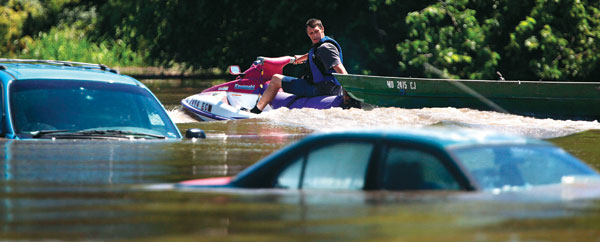
The Missouri River is playfully referred to as the Big Muddy, but the river's flood history is far from comical. Missouri River states have experienced more than a century of flooding dating back to the late 1800s when the river re-channeled itself and created the city of Carter Lake, the only municipality in Iowa located west of the Missouri River.
Besides geographic anomalies, the river has caused death, destruction and hardship for residents along its shores that stretch from Montana through the Dakotas, Nebraska, Iowa, Kansas and Missouri. In 2011 alone, the river has reached record flood levels due to releases of water from reservoirs on the upper Missouri River in Montana and the Dakotas. Here are a few of the worst flood disasters involving the Big Muddy.
April 1881
The first detailed account of Missouri River flooding occurred in 1881 when an ice jam break flooded northeastern Nebraska. The river reportedly swelled to five miles wide, as the floodwaters overwhelmed parts of Iowa and Omaha, killing three people and thousands of livestock while causing damages in the millions -- which would represent a devastating catastrophe in today's dollars. The flooding forced the entire town of Niobrara, Nebraska, to relocate to higher ground.
April 1943
In the spring of 1943, sudden warm weather caused a rapid snowmelt that resulted in massive flooding from Decatur, Nebraska, to Onawa, Iowa. At its peak, water spanned 15 miles between the two towns. The rising waters drowned the Omaha airport in up to seven feet of water, killed one person and caused $1.4 million worth of damage. In the wake of the flood, U.S. Army General Lewis A. Pick initiated floodplain reform in the region.
December 1944
The Flood Control Act of 1944, among other things, created the Pick-Sloan Missouri Basin Program, which granted approval for a complex water control plan along the entire Missouri River Basin. This legislation granted the construction of several dams and man-made lakes including the Fort Peck Dam, Garrison Dam, Lake Sakakawea, Oahe Dam, Big Bend Dam, Fort Randall Dam, Gavins Point Dam, and Lewis and Clark Lake. The act led to the construction of much-needed dams but also destroyed more Native American land than any other public works project in the history of the United States.
Spring 1952
Similar to the cause of the 1943 flood, the 1951 winter produced an unusually heavy snowfall in Montana and the Dakotas that was followed by unseasonably warm weather in April. Massive flooding ensued. Though a series of dams were being built on the Missouri River directly north of Omaha, the Garrison Dam in North Dakota and the Fort Randall and Oahe Dams in South Dakota were unfinished, making the situation worse.
The city of Carter Lake was evacuated as water crested at 34 feet, producing 16-mile-wide floods in lowland areas. President Harry Truman arrived to survey the damage and offer support for flood relief and further flood prevention programs. This was the first Missouri River flood to surpass the severity of the 1881 flood.
April to October 1993
Referred to as the Great Flood of 1993, the Mississippi and Missouri Rivers each swelled beyond control for seven months from April to October, flooding an area of approximately 30,000 square miles and causing $15 to $20 billion in damages. It was the worst U.S. flood disaster since the Great Mississippi Flood of 1927.
Various locations near the Missouri River endured nearly 100 days of flooding while areas on the Mississippi remained flooded for close to 200 days. The water destroyed approximately 100,000 homes, inundated 15 million acres of farmland and killed 32 people.
Summer 2011
The river reached serious flooding stage as the result of record water releases from reservoirs on the upper Missouri River in Montana and the Dakotas. The upper Missouri River Basin received a year's worth of rain during the last half of May, and snow pack runoff into the upper portion of the river was 140% compared to normal, creating perfect flood conditions. In June, several levees along the river failed, creating more devastation.
Flood levels surpassed that of 1952, and by mid-summer, the continuous flooding had covered more than 560,000 acres of mostly rural land, including 447,000 of farmland. The Missouri River was above flood stage in every state it passed through in June and July and even now shows no signs of abating. In fact, the Army Corps of Engineers stated that the river is not expected to recede until the fall since officials must continue to release substantial amounts of water from upstream reservoirs. The engineers have also warned of further flooding due to the possible failure of certain aging levees, saying that the river will eventually rise high enough to flow over at least 18 and perhaps up to 70 levees. Forecasters have predicted that this summer's flooding season could rival the worst in U.S. history.
